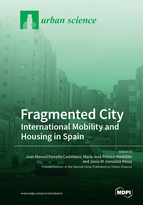Fragmented City: International Mobility and Housing in Spain
A special issue of Urban Science (ISSN 2413-8851).
Deadline for manuscript submissions: closed (1 March 2021) | Viewed by 37653
Special Issue Editors
Interests: urban studies; urban planning; tourism; housing; migration
Interests: urban studies; urban planning; urban landscape; housing; segregation; vulnerability
Special Issues, Collections and Topics in MDPI journals
Interests: urban studies; urban planning; spatial planning; tourism; Europe; Caribbean; Latin America
Special Issues, Collections and Topics in MDPI journals
Special Issue Information
Dear Colleagues,
The Spanish economic model was based, from the beginning of the 1990s, on the growth of construction, tourism, and the internationalization of large business corporations. This model had its best expression during the first decade of the present century until the crisis that began in 2008 led to a profound breakdown of its principles. In the context of redefining Spanish capitalism, in the last five years, a new scheme of accumulation has been consolidated, at least until the crisis generated by the current health pandemic.
The new Spanish capitalist model is based on the devaluation of the cost of labor, the development of tourism, an increase in the export competitiveness of primary and secondary products, and the liberalization of the entry of foreign capital into the property market.
The different positioning of the country's capitalism on the international scene and the succession of situations of crisis and economic expansion have had important consequences in the urban sphere. The general tendency is to increase inter- and intra-urban inequalities, which implies the generation of increasingly fragmented realities.
On an inter-urban scale, dynamic spaces are being consolidated, capable of attracting large international investors and population from abroad, while new forms of tourism and innovative activities related to the recent technological cycle are being developed. On the other hand, urban and rural settlements are growing, which remain outside these new trends and maintain regressive demographic dynamics.
On an intra-urban scale, the city is becoming even more fragmented between the spaces of gentrification and those of exclusion. In the former, tourism and new urban projects become triggers for change while in the latter, poverty, residential segregation, and urban vulnerability are increasing. Housing becomes an indicator of this reality insofar as it is a key element in the processes of accumulation, both because of its production and because of its dispossession.
In this context, this monographic issue is will study the new processes that characterize the Spanish city on different scales in recent years. The relationship between these processes and the changes in the Spanish capitalist model and the urban and social consequences that have resulted are of particular interest.
Prof. Dr. Juan Manuel Parreño Castellano
Dr. María José Piñeira-Mantiñán
Prof. Dr. Jesús González Pérez
Guest Editors
Manuscript Submission Information
Manuscripts should be submitted online at www.mdpi.com by registering and logging in to this website. Once you are registered, click here to go to the submission form. Manuscripts can be submitted until the deadline. All submissions that pass pre-check are peer-reviewed. Accepted papers will be published continuously in the journal (as soon as accepted) and will be listed together on the special issue website. Research articles, review articles as well as short communications are invited. For planned papers, a title and short abstract (about 100 words) can be sent to the Editorial Office for announcement on this website.
Submitted manuscripts should not have been published previously, nor be under consideration for publication elsewhere (except conference proceedings papers). All manuscripts are thoroughly refereed through a single-blind peer-review process. A guide for authors and other relevant information for submission of manuscripts is available on the Instructions for Authors page. Urban Science is an international peer-reviewed open access quarterly journal published by MDPI.
Please visit the Instructions for Authors page before submitting a manuscript. The Article Processing Charge (APC) for publication in this open access journal is 1600 CHF (Swiss Francs). Submitted papers should be well formatted and use good English. Authors may use MDPI's English editing service prior to publication or during author revisions.
Keywords
- gentrification
- housing eviction
- tourism
- internationalization
- large urban projects
- capitalist accumulation
- poverty
- urban vulnerability
- residential segregation
- urban inequalities







